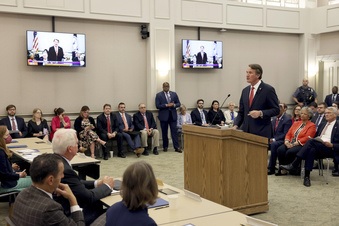RICHMOND, VA – Governor Glenn Youngkin announced that according to BLS Local Area Unemployment Statistics (“LAUS”, or “the household survey”), Virginia’s labor force participation rate, which measures the proportion of the civilian population age 16 and older that is employed or actively looking for work, remained unchanged at 66.6 percent in February.
“In February, we set a new record-high number of Virginians in the labor force, which is encouraging for local businesses trying to fill open jobs and grow in the Commonwealth,” said Governor Glenn Youngkin. “This report reinforces the need for pro-growth policies that move Virginia forward for the Commonwealth’s economy to thrive.”
According to BLS LAUS, Virginia’s seasonally adjusted unemployment rate in February remained unchanged at 3.0 percent, 0.9 percentage points below the national rate. The labor force increased by 3,159 to 4,591,543; the number of employed residents increased by 3,233 to 4,451,840, as the number of unemployed residents decreased by 74 to 139,703.
“Virginia’s unchanged unemployment rate is now nearly a full percentage point below the 3.9 percent national rate,” said Secretary of Labor Bryan Slater. “With the many job openings in the Commonwealth, we maintain our focus on training Virginians in high-demand occupations to continue to increase our labor force participation.”
“It’s encouraging to see historic levels of Virginians joining the labor force and more Virginians working in February,” said Secretary of Commerce and Trade Caren Merrick. “This shows that job seekers are taking advantage of career opportunities in the Commonwealth and supporting our economic development efforts.”
BLS publishes an additional employment figure from its Current Employment Statistics Survey (“CES” or “establishment survey”). The CES survey uses payroll records of establishment employers and is designed to provide a count of jobs under which the employer pays unemployment insurance. The LAUS survey is based on household interviews conducted each month for the Bureau of Labor Statistics and provides comprehensive data on the labor force, including those who are employed and unemployed. Establishment survey data reflects changes for updated seasonal adjustment factors, and industry classification conversions (NAICS), as part of the annual benchmarking process.
The household survey only distinguishes between whether a person is employed or unemployed, whereas CES counts each employee that is on an employer’s payroll. CES excludes business owners, self-employed persons, unpaid volunteers and private household workers, and those on unpaid leave or not working because of a labor dispute.









